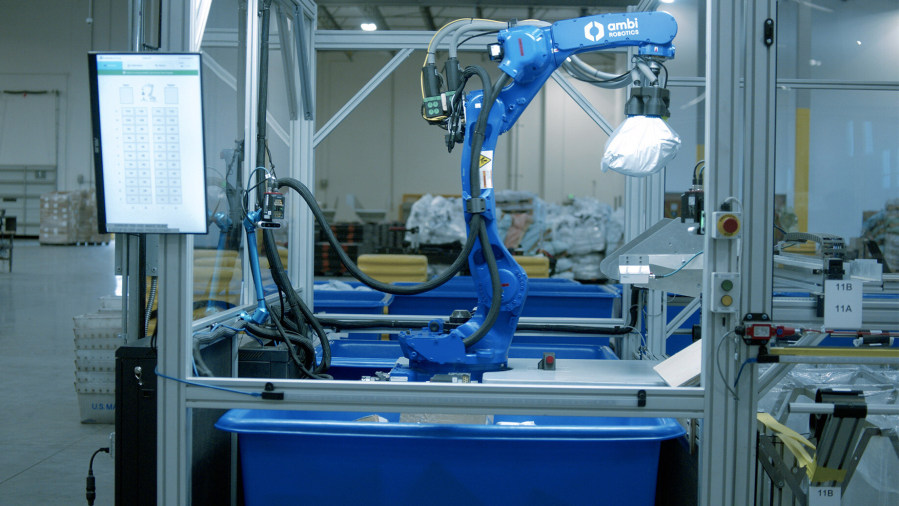Robots are lending a helping hand this holiday season

Last year, the holiday shopping season was kind of a disaster. A lot more people were shopping online because of the pandemic, and millions of packages were delayed or delivered late.
This year could be worse. There are shortages of materials, products, shipping containers and workers. And Deloitte estimates that online sales will jump by 11% to 15% this season.
Retailers are encouraging people to shop as early as possible. Also, they and shipping companies are trying out robots that can help them sort through items.
Ken Goldberg is a professor of industrial engineering at the University of California, Berkeley, and a co-founder of Ambi Robotics, which makes a robot called Ambisort. He said the robots are getting better at sorting. The following is an edited transcript of our conversation.
Ken Goldberg: We’ve come a long way in a year. We’ve gotten a lot better at figuring out where to grasp objects, how to scan them with faster scanners, all the arm motions have been sped up. The system is now ready to do the job. And I think what’s going on is that many vendors around the country, they’re all gearing up and trying out new things. This is going to be a big test year for new technologies. Then, those that work, they’re going to invest very heavily in starting in the spring, so that this will be able to solve these problems continuously in the future.

Marielle Segarra: Can you, can you just sort of describe what it looks like for me?
Goldberg: Just imagine one big bin on one side, and then a blue robot that has a gripper on the end, in fact, it [has] suction cups, and then cameras are all around it. On the other side is another robot arm that sort of moves along and drops the packages into this big array of 25 other bins. So it takes up a fair amount of space, the size of a small room, and the packages come in on one end, and they come out on the other end in the smaller bins assigned to each ZIP code.
Segarra: And how does that speed things up?
Goldberg: Well, it can be very slow to have humans do this, partly because the bins are actually quite deep, so you have to reach way in, which leads to a lot of back injuries. And then a human has to look at each one, figure out where the bar code is, right? That scanning process takes time, and then walk it over to the appropriate bin. So this system speeds up all three aspects. It never gets tired, it can reach deeply into the bin because of the robot. It’s scanned with lots of cameras simultaneously, so it can instantly scan, find the bar code, and then drop it in this scan tray that basically moves it. While the robot goes down to pick up the next object, the first object is being dropped into the appropriate bin.
Segarra: Is this intended to replace a person?
Goldberg: Well, it’s intended to supplement a person. In fact, you know, I think the analogy is, you’re a journalist, right? And there’s probably certain jobs that you don’t particularly like doing, and I would imagine something like transcribing an interview like this. But nowadays, there are tools that can help you do that, that use [artificial intelligence]. They don’t replace the transcription, you would still have to go in and fix it in places, but it can do a lot of the drudgery for you. It just means that you can concentrate on the parts of your job that you do best. And that’s exactly the analogy that we believe is going to be the case for workers and warehouses.
Related links: More insight from Marielle Segarra
This story from MIT Tech Review talks about the other kinds of automation you see popping up in warehouses. Like there’s a robot from the firm Covariant that’s been trained to sort through bins of random items.
That’s been a big challenge for these machines, as Ken Goldberg told us on the show last year.
And big picture: We’ve talked a lot about supply chain shortages and delays, but if you want to know what that actually looks like, The New York Times has a story on the backup at a port in Savannah, Georgia. There are currently 80,000 shipping containers sitting there, 50% more than usual. And ships are waiting at sea to unload for nine days.
That’s just one link in the chain. Boxes of goods are piling up in warehouses because there aren’t enough truck drivers to transport them.
So robots that do sorting. They solve for one problem, speed up one part of the process, but it’s still kind of a mess overall.
The future of this podcast starts with you.
Every day, the “Marketplace Tech” team demystifies the digital economy with stories that explore more than just Big Tech. We’re committed to covering topics that matter to you and the world around us, diving deep into how technology intersects with climate change, inequity, and disinformation.
As part of a nonprofit newsroom, we’re counting on listeners like you to keep this public service paywall-free and available to all.
Support “Marketplace Tech” in any amount today and become a partner in our mission.












